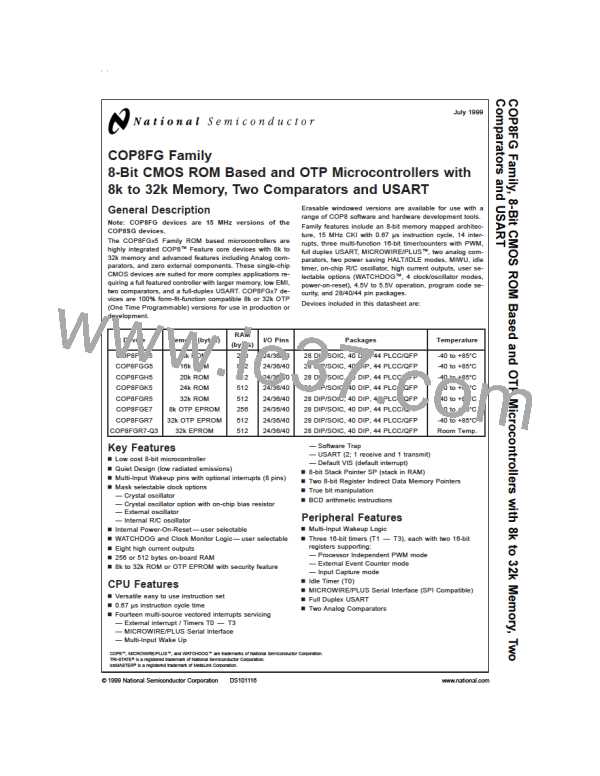The available addressing modes are:
14.0 Instruction Set
•
•
•
Direct
14.1 INTRODUCTION
Register B or X Indirect
This section defines the instruction set of the COPSAx7
Family members. It contains information about the instruc-
tion set features, addressing modes and types.
Register
B or X Indirect with Post-Incrementing/
Decrementing
•
•
•
Immediate
Immediate Short
Indirect from Program Memory
14.2 INSTRUCTION FEATURES
The strength of the instruction set is based on the following
features:
The addressing modes are described below. Each descrip-
tion includes an example of an assembly language instruc-
tion using the described addressing mode.
•
•
•
•
•
•
Mostly single-byte opcode instructions minimize program
size.
Direct. The memory address is specified directly as a byte in
the instruction. In assembly language, the direct address is
written as a numerical value (or a label that has been defined
elsewhere in the program as a numerical value).
One instruction cycle for the majority of single-byte in-
structions to minimize program execution time.
Many single-byte, multiple function instructions such as
DRSZ.
Example: Load Accumulator Memory Direct
LD A,05
Three memory mapped pointers: two for register indirect
addressing, and one for the software stack.
Reg/Data
Memory
Contents
Before
Contents
After
Sixteen memory mapped registers that allow an opti-
mized implementation of certain instructions.
Ability to set, reset, and test any individual bit in data
memory address space, including the memory-mapped
I/O ports and registers.
Accumulator
Memory Location
0005 Hex
XX Hex
A6 Hex
A6 Hex
A6 Hex
•
•
Register-Indirect LOAD and EXCHANGE instructions
with optional automatic post-incrementing or decrement-
ing of the register pointer. This allows for greater effi-
ciency (both in cycle time and program code) in loading,
walking across and processing fields in data memory.
Register B or X Indirect. The memory address is specified
by the contents of the B Register or X register (pointer regis-
ter). In assembly language, the notation [B] or [X] specifies
which register serves as the pointer.
Example: Exchange Memory with Accumulator, B Indirect
X A,[B]
Unique instructions to optimize program size and
throughput efficiency. Some of these instructions are
DRSZ, IFBNE, DCOR, RETSK, VIS and RRC.
Reg/Data
Memory
Contents
Before
Contents
After
14.3 ADDRESSING MODES
The instruction set offers a variety of methods for specifying
memory addresses. Each method is called an addressing
mode. These modes are classified into two categories: oper-
and addressing modes and transfer-of-control addressing
modes. Operand addressing modes are the various meth-
ods of specifying an address for accessing (reading or writ-
ing) data. Transfer-of-control addressing modes are used in
conjunction with jump instructions to control the execution
sequence of the software program.
Accumulator
Memory Location
0005 Hex
01 Hex
87 Hex
87 Hex
01 Hex
B Pointer
05 Hex
05 Hex
Register
B or X Indirect with Post-Incrementing/
Decrementing. The relevant memory address is specified
by the contents of the B Register or X register (pointer regis-
ter). The pointer register is automatically incremented or
decremented after execution, allowing easy manipulation of
memory blocks with software loops. In assembly language,
the notation [B+], [B−], [X+], or [X−] specifies which register
serves as the pointer, and whether the pointer is to be incre-
mented or decremented.
14.3.1 Operand Addressing Modes
The operand of an instruction specifies what memory loca-
tion is to be affected by that instruction. Several different op-
erand addressing modes are available, allowing memory lo-
cations to be specified in a variety of ways. An instruction
can specify an address directly by supplying the specific ad-
dress, or indirectly by specifying a register pointer. The con-
tents of the register (or in some cases, two registers) point to
the desired memory location. In the immediate mode, the
data byte to be used is contained in the instruction itself.
Example: Exchange Memory with Accumulator, B Indirect
with Post-Increment
X A,[B+]
Reg/Data
Memory
Contents
Before
Contents
After
Each addressing mode has its own advantages and disad-
vantages with respect to flexibility, execution speed, and pro-
gram compactness. Not all modes are available with all in-
structions. The Load (LD) instruction offers the largest
number of addressing modes.
Accumulator
Memory Location
0005 Hex
03 Hex
62 Hex
62 Hex
03 Hex
B Pointer
05 Hex
06 Hex
Intermediate. The data for the operation follows the instruc-
tion opcode in program memory. In assembly language, the
number sign character (#) indicates an immediate operand.
www.national.com
44

 NSC [ National Semiconductor ]
NSC [ National Semiconductor ]